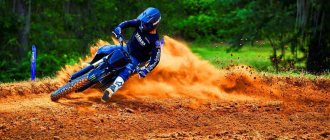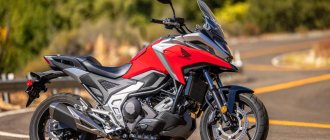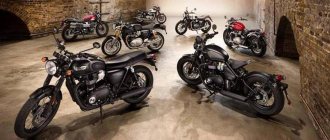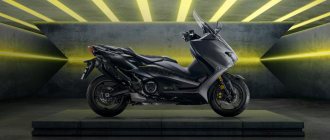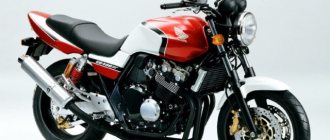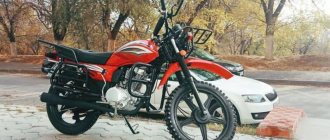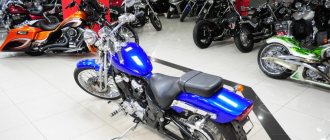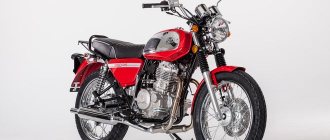BMW K1200GT
Model class : sport-tourist
Years of production/sales : 2002-2008
BMW K1200GT model was first introduced in 2002 and is built on the basis of the frame, engine and chassis of the BMW K1200RS, differing from the latter in more developed wind protection, an electrically adjustable windshield, a wider saddle and more comfortable ergonomics of the handlebars and footpegs.
Main generations of BMW K1200GT:
- BMW K1200GT K41 (2002-2005) – first generation. Models of these years are built on the basis of the BMW K1200RS and differ in plastic design. Engine: longitudinal 4-cylinder block 1171 cc. at 130 hp
- BMW K1200GT K44 (2006-2008) – second generation. The model gets a new look, a new 1157 cc vertical engine. see at 152 hp from K1200S and K1200R, Duolever instead of Telelever and semi-integral ABS III without electric boost. Electronic suspension adjustment is available as an option.
Otherwise, the BMW K1200GT model has the classic features of BMW K-series motorcycles: an in-line 4-cylinder liquid-cooled engine, proprietary Telelever and Paralever suspensions, ABS and a cardan drive. Touring options include an adjustable steering wheel and saddle, heated grips, electrically adjustable windshield height, standard saddlebag mounts, cruise control, etc.
The BMW K1200GT model was produced until the end of 2008, after which it was replaced by an updated version - the BMW K1300GT.
Specifications
Technical characteristics of BMW K1200GT:
| Model | BMW K1200GT |
| Motorcycle type | sports tourist |
| Year of issue | 2002-2008 |
| Frame | aluminum |
| engine's type | 4-cylinder in-line, longitudinal (from 2006 - transverse) arrangement |
| Working volume | 1172 cc (since 2006 - 1157 cc.) |
| Bore x Stroke | 70.5x75 mm (since 2006 79x59 mm) |
| Compression ratio | 11.5:1 (since 2006 - 13.0:1) |
| Cooling | liquid |
| Number of valves | DOHC, 4 valves per cylinder |
| Fuel supply system | Bosch Motronic MA 2.4 injector (from 2006 - BMW-K) |
| Ignition type | electronic |
| Maximum power | 130 hp at 8750 rpm (since 2006 - 152 hp at 9500 rpm) |
| Maximum torque | 117 Nm at 6750 rpm (since 2006 - 130 Nm at 7750 rpm) |
| Transmission | 6-speed |
| type of drive | cardan |
| Front tire size | 120/70 ZR17 |
| Rear tire size | 180/55 ZR17 |
| Front brakes | 2 discs, 320 mm, 4-piston calipers (ABS) |
| Rear brakes | 1 disc, 285 mm, 4-piston caliper (ABS) (from 2006 - 294 mm, 2-piston caliper) |
| Front suspension | BMW Telelever, stroke - 115 mm (since 2006 - Duolever) |
| Rear suspension | pendulum BMW Paralever (preload and rebound adjustment), stroke - 150 mm (since 2006 - 135 mm) |
| Overall dimensions (LxWxH) | 2250 x 920 x 1340 mm (since 2006 - 2318x990x1438 mm) |
| Seat height | 820-840 mm (800-820 mm - with low seat) |
| Gas tank capacity | 20.5 l (since 2006 - 24 l) |
| Maximum speed | 230 km/h (since 2006 - 253 km/h) |
| Acceleration to 100 km/h (0-100) | 3.4 sec (since 2006 - 2.8 sec) |
| Motorcycle weight (curb) | 300 kg (since 2006 - 282 kg) |
BMW K1200RS
BMW K1200RS Motorcycle BMW K1200RS - main technical characteristics: Model range: BMW K1200RS; Engine type: four-cylinder, in-line, liquid-cooled, 16-valve, DOHC; Engine displacement, cm3: 1171; Maximum power, horsepower: 130; there is 98 hp. Engine speed at maximum power, rpm: 8750; Top speed km/h (mph): 256 (160); Frame: open, made of aluminum profiles Tires: front 120/70 17, rear 170/60 17 Drive: cardan shaft Gearbox: 6-speed Total weight of the motorcycle, kg: 285. side cases - basic equipment for the BMW K 1200 RS
During inspection, the motorcycle was started and it immediately began to smoke (it sat for at least 1 week, and maybe more, on the left step). Warmed it up, revved it up, drove it, it still smokes. It was a shame, it seemed like a well-maintained motorbike, all the consumables were normal, and here it is! BUT, after turning it off, we stood around for about 2 minutes chatting with the seller and decided to start it again and... oh MIRACLE, the motorcycle works so there is no hint of smoke coming out of the chimney, it works like a clock, we drove around, everything is OK, the smoke just disappeared. And here’s the question, dear forum users, what was IT, is it really what was described on the Internet, that it should be stored on the center step, and why did the smoke not disappear until the engine was turned off and turned on again? Oil flows towards the head from here and smoke after starting.
I have the same design. I scare the gentle owners of rice mills by turning up the gas after the start. There is smoke there, like from an ancient Kamaz :rofl:. The motor is actually difficult to kill and heavily strangled by engineers for the sake of resource. The worse it is, the less oil it eats.
60 thousand service requires replacing the timing chain tensioners. This is the manufacturer's recommendation (according to the manual). In real mode, the tensioner bars are usually changed at 60,000 km, because the chain on these engines runs at 100,000 km! At least that's how it was for me, I didn't have to change it.
In addition, to perform this procedure, the engine does not need to be removed. It is enough to remove the plastic and unscrew the front and top covers of the internal combustion engine. In general, replacing a chain takes about 5 hours of work slowly. It is much more difficult to change the clutch, then all that remains is the frame and the front fork with the wheel. The bike is good and reliable. The clutch pattern is like on cars. Most oil seals will fit from Gazelle. Like all other models, there is a lot of all sorts of original tuning and bells and whistles. The circuit of the entire bike has been worked out and tested for decades. The plastic is quite durable and thick and does not crack or creak due to age. The main problem with these bikes is that it is very difficult to find them in good condition and with low mileage, and in Russia it is simply impossible. For a good bike the price will not be humane, and the customs payment on them is absolutely not childish......
About ABS errors: if you change the brake fluid with a constant flow, then nothing will come out. The error appears only in the event of a critical drop in quantity. The error must be removed from the officials or bought a scanner. It is worth changing the brake fluid more often and there will be no problems with abs. Until 2002, bimmers were equipped with abs, from which errors can only be removed with a scanner. I got tired of going to the od and ended up buying one for myself; I read it myself and correct mistakes. Thing!!! Now I completely do without service - the device is simple, you can do everything yourself, and with a scanner it’s even easier - it shows the operation of any sensor. all this, in principle, applies to all bimmers older than 5 years.
BMW K1200GT 2003 Buyer's advice. March 31, 16:34 Well, my “brick” has been sold... I doubted and wondered for a long time whether it was worth selling and what the prospects were for the future. But after my wife’s reasons and arguments in favor of buying the next GT model, I finally decided. Over all the years of owning this device and driving almost 80,000 km, I have accumulated a sufficient information base on the maintenance, operation and intricacies of maintaining this model, which I want to share with you. This information will be especially useful for those who are planning to have this animal in their garage.
So. You have decided with complete confidence that your next horse will be a BMW K1200GT/RS (K41) and have already found a suitable option that you are ready to go see. What should you pay attention to in order to protect yourself as much as possible from being caught?
Appearance. We do not take chips and small scratches into account. The motorcycle is a touring motorcycle, not new, and, as a rule, it is ridden a lot, quickly, and far, so you shouldn’t really find fault with this. In cases of falls, the driver's footrests of a motorcycle of this model often suffer. They are aluminum and break easily. Pay attention to them. So that there are no traces from attempts to weld with argon.
Also pay attention to the engine crankcase cover, it is visible in the hole on the right side of the plastic sidewall. In cases of falling on the right side, the engine cover may even break through. Look inside the motorcycle frame, below, on the right side, where the gearbox is. There should be no oil smudges or evaporation at the junction of the gearbox and engine. This threatens to replace the gearbox shaft seal and completely disassemble the motorcycle.
Carefully inspect the cardan and gearbox. All rubber cuffs must be dry and free of oil smudges and oil stains. Especially at the junction of the cardan cover and the gearbox, on the right, at the back. If traces of oil are visible there, then this threatens to replace the gearbox seal and, most likely, the gearbox bearings. Place the motorcycle on the center stand with the rear wheel hanging out. Grasp the wheel with both hands and rock it perpendicular to the motorcycle. The wheel should fit tightly and there should be no play or even the slightest knock. If there is play or a “buck-buck” sound, this means that the main (large) gearbox bearing requires replacement
Carefully inspect the front of the motorcycle, under the headlight, the ball joint seats where the fork is attached. The sealing rubber must be dry and free of cracks. If there are cracks, then most likely there is already dirt and sand inside, which will lead to rapid wear and the need for subsequent replacement of the support. Grasp the ball joint with your hand and turn the steering wheel left and right. At the same time, no creaks, noises or “biting” should be heard.
Pay attention to the steering damper (under the headlight, on top of the front fender). It must have a free, small, easy movement left and right and have no external damage, and must be dry. (keep in mind that you shouldn’t swing the fork while sitting on a motorcycle and pulling the rail from top to bottom and up. It won’t push through, since this is not a telescope).
Take the time to look under the bottom of the motorcycle and inspect the oil filter housing cover. It should be dry. if there are traces of oil and smudges, it means that the filter rubber seal most likely has not been changed and dirt could have gotten into the oil.
Inspect the brake discs. There should be no cracks or other defects. The K1200GT has a very powerful, smart braking system and the use of non-original brake pads very quickly leads to wear on the brake discs. If the thickness of the discs is less than 4mm, then they need to be replaced.
Turn on the ignition. You should hear several clicks, the hum of the injector and a characteristic short sound ("zip") of the brakes working properly. When you press the brake handle or pedal, you should hear the sound of the servo amplifiers operating - “vvvzhzhzhzhzh”. If the pedal or lever is released, the sound disappears. This indicates a working servo drive system. The red ignition lamp on the display should be on and the ABS light should be flashing. This indicates that the brake system self-diagnosis has passed successfully and the brakes are ready for use.
Start the engine. Don't be scared! The BMW engine runs really harshly and can give the impression that it is faulty. Is there bluish smoke coming out of the chimney? - this is absolutely normal! Especially if the motorcycle has not been driven for a long time or has been standing on the side stand. This should not be taken as wear of the piston group or as another engine malfunction. Accept it for its peculiarity. After 10-15 minutes, turn off the engine, wait 3-5 minutes and start again, and there will be no more smoke. Do you hear a monotonous, fairly clear knocking sound in the checkpoint area? — this is how a dry clutch works. Press the clutch lever and the sound may become muffled or disappear altogether. This is also normal and is a feature of the motorcycle. My personal observation shows that absolutely all K41s knock. For some, the knock is louder, for others it is quieter, but the clutch knock is present in all of them. And that's okay. Check all electrical equipment of the motorcycle. Turn on the heated steering wheel and seat. Raise and lower the window. Turn on the turn signals and emergency lights. Check the operation of all signaling and lighting devices. Everything should work. The buttons on the steering wheel controls should move smoothly, without sticking. Turn off the ignition. Turn it on and press the “start” button again! The engine should start easily and almost instantly. If it is slow, the spark plugs or battery may need to be replaced.
If you are lucky and get a test drive! Engage first gear. The characteristic hard “CLATCH!” will be displayed as the number “1” on the instrument panel - this means that the gearbox indicator is working properly. We release the clutch and moving away occurs approximately in the middle - or 3/4 of the lever stroke. If the clutch engages “at the end”, then there are two options; 1) it is necessary to adjust the clutch handle to suit you, changing the position of the washer on the handle to a higher number, 2) if the washer is at No. 4, and the clutch is also “at the end”, then this is the first signal to quickly replace the disc spring of the clutch basket and, most likely, the entire basket. And this is a very labor-intensive job, which I wrote about in the previous supplement.
Once moving, at low speed the motorcycle may seem like a lump! Yes, it has a tendency to stall at speeds up to 30 km/h. But with increasing speed it should become lighter and more obedient. Switch to different gears. The gears should engage quite firmly (this is not a Honda), but easily and clearly! The number of the selected gear should be displayed on the instrument panel indicator. At a speed of 35-40 km/h, engage third gear and sharply open the gas - the motorcycle should accelerate without jerking, sneezing or choking, smoothly but with steadily increasing power. If there is a jerk, or a loud bang, or choking, the air filter needs to be replaced with cleaning of the intake channel, and possibly a complete replacement of the pipes. If there is an increase in engine speed, but the speed is gained slowly or with characteristic “slippage,” then this is a 100% signal that the clutch requires replacement.
When driving for the first time, be careful with your brakes! Brake very gently and smoothly! A motorcycle, with its powerful and sharp braking, can even scare you! In second gear, accelerate to 60 km/h and engage neutral. Then smoothly, slightly, press the front brake lever and hold it without increasing the force. You should feel how the motorcycle itself slows down and the deceleration occurs, as it were, in waves, but without your participation. This indicates a fully functional brake system.
If you have the opportunity and space, check the cruise control. The yellow light on the panel should light up. Accelerate to 60 km/h and turn on cruise by pressing the button to your left. The throttle should seem to turn a little. Press the same key again “from yourself” - the speed should increase. Press “towards you” - the speed should decrease. Press the brake - the yellow light should go out and the motorcycle should begin to slow down. This means that the cruise control system is working properly. If the cruise does not turn on or jerks occur, then check to see if the throttle cables coming from the right handle are pinched.
Well, we have considered, perhaps, all the points that you need to pay attention to when inspecting and choosing this motorcycle. In general, the K1200GT is a very reliable motorcycle with a colossal reserve of service life and does not cause any special problems in operation. The main thing is to change the oil, filters and do a comprehensive full inspection at least once a year. I always did this in the winter, and all summer it was just “gasoline, oil and wash”.
